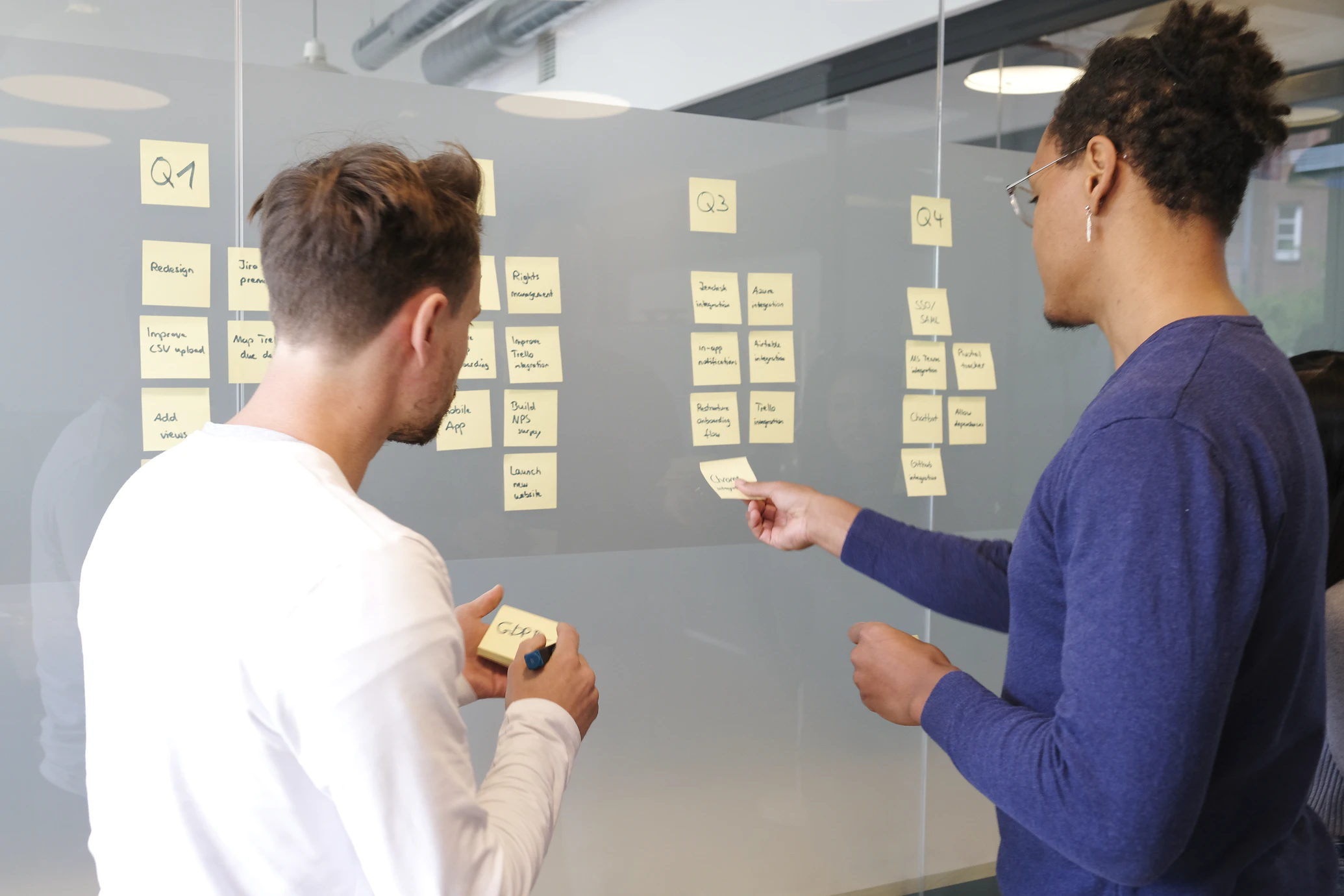How to Incorporate Agile 2.0 Into Your Company Strategy
What is Agile 2.0 and why should you care to adopt agile principles in your company? Find out in this guide from our CEO!

Table of Contents
What’s holding you back from achieving more?
This question kept haunting me ever since I had to refuse a customer for the very first time. Our company didn’t have the capacity to take another project at that moment.
It was a tough decision to make, obviously. However, it was an important lesson in retrospective as well.
I kept asking myself: how I can improve the company’s performance without hiring a ton of new people, investing into aggressive training or compromising the product quality?
A decade ago adjectives like “quick”, “light”, “nimble” were rarely used in relation to software development. In fact, they are not the primary service selling points for most software companies these days either.
Complicated development cycles, detailed process scrutiny, loads and loads of meetings – all of those results into delayed software development cycles, lower project capacity and additional costs for you as a potential customer.
So is there a cure for that?
Yes. In our case, incorporating agile 2.0 approach as the core part of the company’s business strategy turned out to be the game-changing element.
Here’s a quick story of the agile movement and why going ultra light may stand for more clients, more efficient performance and better work environment.
Table of Contents
What is Agile and Why Should You Care?
So you’ve heard “agile software development”, “agile project management”, “going agile” and things like that quite a few times.
Does “agile” stand for another buzzword?
Not exactly. There’s a bigger deal behind that.
Here’s why and how the agile movement actually started.
On a snowy February day back in the 90s, seventeen professional project managers and software developers gathered in a warm cabin after a long day of skiing. While all of them worked on different types of projects, they all faced the same notorious issue – extremely heavyweight software development processes.
Allow me to illustrate this:
Imagine a top swimmer aiming for the Olympic gold. However, instead of Speedos and goggles, he’s wearing a full diving armor of a heavy rubber suit, aqualung and a backpack in the front with some extra weights. At the same time he is expected to report of his progress through a waterproof microphone and follow the instructions sent through an earphone.
Sounds obscure, right?
Well, that’s exactly how heavyweight methodology looks like.
Here’re some more curious numbers:
- Rational Unified Process framework is estimated to have over 120 processes.
- Waterfall project management method, developed by PMI, suggests over 42 processes, plus rules, roles and artifacts.
At this point, the need for a lighter, simpler and more efficient methodology seems rather obvious.
Hence, the original agile movement started. The layering principles were created and outlined in the official manifesto.
What is Agile 2.0?
Ok, so agile stands for a “lighter” approach to software development, management and organization in general. Less tools, less processes, less hassle – this all can be summed up as “agile”.
Is there a point of going beyond that?
Yes. The core values of the original agile manifesto are still up-to-date and continue to guide us in the right direction:
- Place more value on People and Communication, rather than tools and processes.
- Working Software as the ultimate goal.
- Collaboration over negotiations.
- Embracing Changes, rather than sticking to the plan.
However, some of us got a bit off-track in the process.
For instance, Extreme Programming approach now incorporates at least 13 primary practices, 11 corollary practices and 12 rules, which ads up to 24 to 36 components in total. Doesn’t sound particularly lightweight, right?
In 10 years after the original Agile Manifesto was published, Geert Bossuyt from Xebia offered a fresher perspective on the matter, called MoreAgile Manifesto.
Peter Saddington from Agile Scout took after and spiced up the story with additional commentary in his blog post: Agile Manifesto 2.1 – “MoreAgile Manifesto”.
When re-establishing our development framework in 2015, we have slightly modified and adopted the core Agile 2.0. principles as the integral part of the company’s strategy.
How Your Company Can Incorporate Agile 2.0 Principles
A winning strategy is based on the layering principles.
Defining the core principles of your company and aligning them with the company’s values should be your number one priority. Do invite your team for active participation as well.
Agile 2.0. Principle One: Teamwork & Responsibility
Choose the right framework to empower knowledge sharing, foster commitments and shared responsibility at all levels.
For instance, we love SCRUM and collectively chose to adopt it as the primary software development framework.
SCRUM itself is built on the top agile principles as it challenges the traditional sequential approach to product development; fosters teamwork and responsibility by encouraging close involvement for all team members, as well as daily face-to-face communication. Our team now works more efficiently as a single unit to reach the final goal.
However, here’s the deal with SCRUM – it’s easy to understand but extremely difficult to master.
While the transition period might be a bit rough for your company, do keep the long-term benefits in mind. All SCRUM events and procedures e.g. The Commitment List, Storytime Meetings, Retrospective and Demo are essential for ultimate success in the long run.
Agile 2.0 Principe Two: Deliver Value
To cut it short, the agile approach expects each action to bring exact value. No meetings for the sake of meetings or a process for the sake of having one!
It is simple as is – be beyond than above.
For instance, if you are in software development company like us, you can brainstorm the following questions with your stakeholders:
- Do we understand the difference between our customers and the actual users of our software?
- Do we know our customer and the user experience circle?
- What features do our users like and dislike in our software?
- Do we understand our users’ priorities? Is this particular feature we are developing right now is truly relevant?
- In what ways can we decrease the negative experience, the irritation, the frustration, the time wasted and the delays?
Agile 2.0 Principe Three: Partnership Elaboration
Relationships matter above everything.
As Jill Konrath brilliantly puts it:
“Your products, services, or solution are secondary to your knowledge, expertise and the difference you make for your customers.”
Ask yourself: What can I do for my customer? How can I help his company to do better business?
Be proactive and deliver a tad bit more than the customer expects from you. For example, you can research your customer’s niche well in advance and send the information before they even asked for it. Be an over-achiever and always stay one step ahead.
Outline your client’s needs and give, give, give, give, give… That’s how long-term partnership relationships are established.
Agile 2.0 Principe Four: Prepare For Change
You should never settle for who you are.
We live by the principle that there’s always more room both for personal and professional growth – getting new certifications, mastering additional skills and learning new technologies.
Your and your company’s success highly depends on everyday learning. Attend niche tech events and conferences, take professional courses, and support R&D centers. New business opportunities arise from constant change and progress.
Don’t settle for less, when there’s still room for more.
If you feel ready to change the way your company operates to Agile 2.0. principles, here are the key steps you should take:
- Define the key principles of you and your organization believes in;
- Encourage your team to create and nourish the culture they feel comfortable in;
- Build your custom framework to support the principles, core values and culture of your organization, which also align with your company mission;
- Keep the teams and the customers happy;
- Continue learning every day;
- Love what you do and respect others.;
- Rinse and repeat the best practices.



